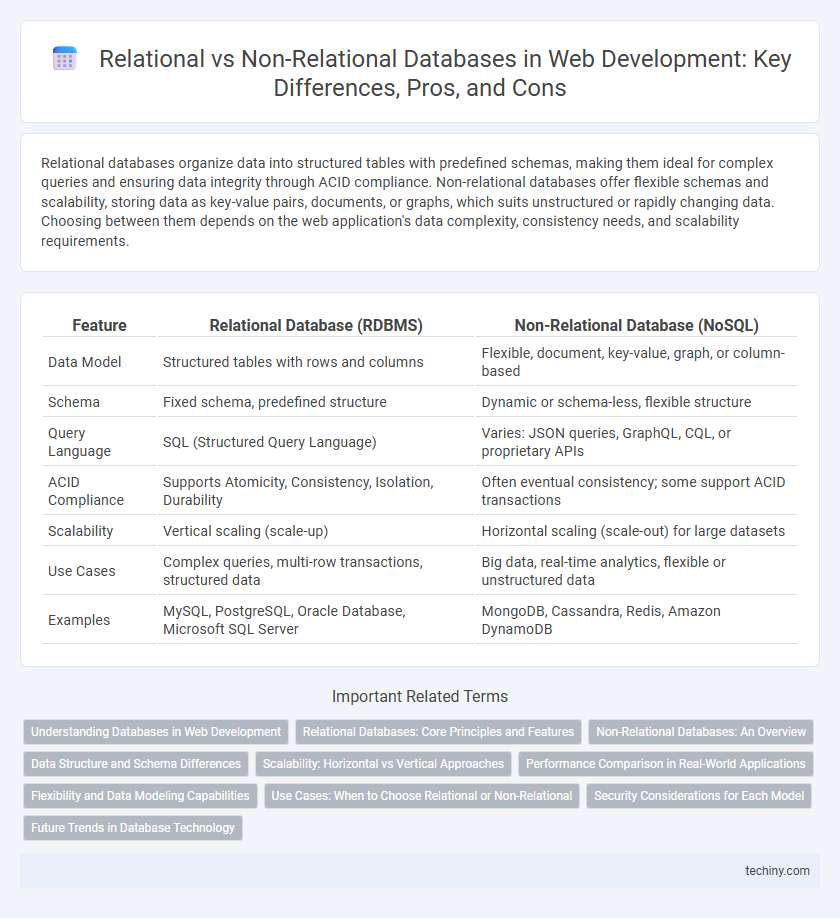Relational databases organize data into structured tables with predefined schemas, making them ideal for complex queries and ensuring data integrity through ACID compliance. Non-relational databases offer flexible schemas and scalability, storing data as key-value pairs, documents, or graphs, which suits unstructured or rapidly changing data. Choosing between them depends on the web application's data complexity, consistency needs, and scalability requirements.
Table of Comparison
| Feature | Relational Database (RDBMS) | Non-Relational Database (NoSQL) |
|---|---|---|
| Data Model | Structured tables with rows and columns | Flexible, document, key-value, graph, or column-based |
| Schema | Fixed schema, predefined structure | Dynamic or schema-less, flexible structure |
| Query Language | SQL (Structured Query Language) | Varies: JSON queries, GraphQL, CQL, or proprietary APIs |
| ACID Compliance | Supports Atomicity, Consistency, Isolation, Durability | Often eventual consistency; some support ACID transactions |
| Scalability | Vertical scaling (scale-up) | Horizontal scaling (scale-out) for large datasets |
| Use Cases | Complex queries, multi-row transactions, structured data | Big data, real-time analytics, flexible or unstructured data |
| Examples | MySQL, PostgreSQL, Oracle Database, Microsoft SQL Server | MongoDB, Cassandra, Redis, Amazon DynamoDB |
Understanding Databases in Web Development
Relational databases use structured schemas and SQL for managing data, making them ideal for applications requiring ACID compliance and complex queries. Non-relational databases, such as MongoDB and Cassandra, store unstructured or semi-structured data, offering scalability and flexibility for large-scale web applications with diverse data types. Understanding these database models in web development helps optimize performance, data integrity, and scalability based on specific project requirements.
Relational Databases: Core Principles and Features
Relational databases organize data into tables with predefined schemas, using structured query language (SQL) for efficient data manipulation and retrieval. They emphasize data integrity through constraints like primary keys, foreign keys, and normalization to minimize redundancy and ensure consistency. Core features include ACID (Atomicity, Consistency, Isolation, Durability) compliance, enabling reliable transaction processing critical for applications requiring precise data management.
Non-Relational Databases: An Overview
Non-relational databases, also known as NoSQL databases, prioritize flexibility and scalability by storing data in formats such as key-value pairs, documents, wide-columns, or graphs. They excel in handling large volumes of unstructured or semi-structured data, making them ideal for real-time web applications, big data analytics, and content management systems. Popular non-relational databases include MongoDB, Cassandra, Redis, and Neo4j, each optimized for distinct data models and use cases in modern web development.
Data Structure and Schema Differences
Relational databases use structured tables with predefined schemas enforcing data integrity through fixed columns and data types, ideal for complex queries and transactions. Non-relational databases, such as document stores or key-value pairs, allow flexible, schema-less designs enabling rapid scalability and handling of diverse data formats like JSON or XML. The choice between them depends on application needs for consistency, scalability, and the nature of the data relationships.
Scalability: Horizontal vs Vertical Approaches
Relational databases typically scale vertically by increasing the hardware capacity of a single server, which can lead to limitations in handling high traffic and large datasets. Non-relational databases excel in horizontal scalability, distributing data across multiple servers or nodes to manage extensive workloads efficiently. This horizontal scaling approach enables faster performance and greater flexibility for web applications experiencing rapid growth.
Performance Comparison in Real-World Applications
Relational databases excel in structured data management with complex queries and transactional consistency, making them ideal for financial applications requiring ACID compliance and reliable joins. Non-relational databases offer superior performance in handling large volumes of unstructured or semi-structured data with horizontal scalability, often resulting in faster read/write speeds for big data analytics and real-time web applications. Real-world benchmarks show relational databases perform efficiently under complex query loads, while non-relational databases achieve higher throughput and lower latency in distributed environments.
Flexibility and Data Modeling Capabilities
Relational databases excel in structured data environments by enforcing strict schemas and relationships through tables, ensuring data integrity and consistency. Non-relational databases offer superior flexibility with dynamic schemas and support for varied data models such as documents, key-value pairs, graphs, and wide-columns, enabling seamless handling of unstructured or evolving data. This flexibility makes non-relational databases ideal for applications requiring rapid iteration and diverse data types, while relational databases remain optimal for transactional systems demanding complex queries and rigid data validation.
Use Cases: When to Choose Relational or Non-Relational
Relational databases excel in scenarios requiring structured data with complex relationships, such as financial systems, customer relationship management (CRM), and inventory management, due to their support for ACID transactions and SQL queries. Non-relational databases are ideal for handling unstructured or semi-structured data, high scalability, and flexible schemas, making them suitable for content management systems, real-time analytics, and IoT applications. Choosing between relational and non-relational databases depends on factors like data consistency needs, schema rigidity, query complexity, and scalability requirements.
Security Considerations for Each Model
Relational databases enforce strong data integrity through structured schemas and ACID (Atomicity, Consistency, Isolation, Durability) compliance, making them highly secure for transactions requiring strict consistency. Non-relational databases, such as NoSQL models, offer flexible schema designs but may lack comprehensive built-in security features, necessitating additional layers like encryption and access control for data protection. Understanding the specific security capabilities and limitations of each database type helps developers implement appropriate measures to safeguard sensitive information in web applications.
Future Trends in Database Technology
Future trends in database technology highlight the growing adoption of hybrid systems that integrate relational and non-relational databases to optimize scalability and flexibility in web development. Cloud-native databases leveraging machine learning enhance query performance and automate schema evolution, meeting the demands of dynamic web applications. Advances in distributed ledger technology also influence database architectures, promoting data integrity and decentralized access models.
Relational Database vs Non-Relational Database Infographic

 techiny.com
techiny.com